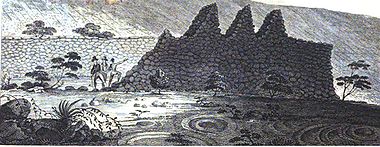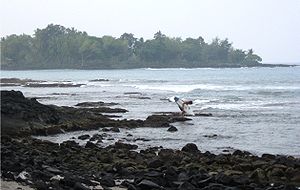
Holualoa Bay
Encyclopedia

Keauhou Bay
Keauhou Bay is a historic area in the Kona District of the Big Island of Hawaii.The name comes from ke au hou which means "the new era" in the Hawaiian Language.-Kamehameha III's Birthplace:...
in the Kona District
Kona District, Hawaii
Kona is the name of a moku or district on the Big Island of Hawaii in the State of Hawaii. In the current system of administration of Hawaii County, the moku of Kona is divided into North Kona District and South Kona District . The term "Kona" is sometimes used to refer to its largest town,...
of the Big Island of Hawaii
Hawaii (island)
The Island of Hawaii, also called the Big Island or Hawaii Island , is a volcanic island in the North Pacific Ocean...
. The community now called Hōlualoa is uphill (mauka in the Hawaiian Language
Hawaiian language
The Hawaiian language is a Polynesian language that takes its name from Hawaii, the largest island in the tropical North Pacific archipelago where it developed. Hawaiian, along with English, is an official language of the state of Hawaii...
) from this bay.
The name means "long slide" in the Hawaiian Language
Hawaiian language
The Hawaiian language is a Polynesian language that takes its name from Hawaii, the largest island in the tropical North Pacific archipelago where it developed. Hawaiian, along with English, is an official language of the state of Hawaii...
, from the long trail that went from a forest on the slopes of Hualālai
Hualalai
Hualālai is a dormant shield volcano on the island of Hawaii in the Hawaiian Islands. It is the third-youngest and the third most active of the five volcanoes that form the island of Hawaii, following Kīlauea and the much larger Mauna Loa, and also the westernmost. Its peak is above sea...
(where the village is now), to a site where the logs were made into canoes (on the grounds of Sadie Seymour Botanical Gardens
Sadie Seymour Botanical Gardens
The Sadie Seymour Botanical Gardens are nonprofit botanical gardens located on the grounds of the Kona Outdoor Circle Educational Center at 76-6280 Kuakini Highway, Kailua-Kona, Hawaii island, Hawaii. Coordinates are . They are open daily; admission is free, but donations accepted.Sadie Seymour ...
) into this bay where a large royal building complex was built over several centuries.
History
KeakealaniwahineKeakealaniwahine
Chiefess Keakealani Wahine was the 20th ruler of Hawaii island from 1665 to 1695.-Life:Her mother was Queen Keaka-mahana, 19th Alii Aimoku of Hawaii island. Her father was Chief Iwikau-i-kaua of Oahu. She became ruler of the island on the death of her mother, 1665...
, one of the first known Alii Aimoku
Alii Aimoku of Hawaii
The following is a list of alii aimoku of Hawaii. "Alii aimoku" refers to the ruler of the island. alii refers to the ruling class of ancient Hawaii...
wahine ("Queens") of the entire island of Hawaii, built a large complex of buildings here in the seventeenth century, with the area settled several hundred years before that.
The royal complex included residential areas, as well as Heiau
Heiau
A heiau is a Hawaiian temple. Many types of heiau existed, including heiau to treat the sick , offer first fruits, offer first catch, start rain, stop rain, increase the population, ensure health of the nation, achieve success in distant voyaging, reach peace, and achieve success in war . Only the...
s (ancient temples) called Hikapaia (for plentiful food and fish) and Hualani (for teaching about medicinal herbs), and burial areas.
Keakamahana
Keakamahana
Keaka-mahana was the 19th Alii Aimoku of Hawaii island 1635–1665. She ruled as sovereign Queen or Chiefess of the island from the royal complex at Holualoa Bay....
, the mother of Keakealaniwahine, was the first named royalty to live here.
This area (uphill or mauka of Alii drive) was added to the National Register of Historic Places
National Register of Historic Places
The National Register of Historic Places is the United States government's official list of districts, sites, buildings, structures, and objects deemed worthy of preservation...
on June 8, 2005, as the Holualoa 4 Archeological District with site number 05000542.
It is State Archeological site number 50-10-37-23.661.
The Kamoa Point Complex, the area West of Alii drive on the south side of the bay, included a temple for surfers, called the Haleaama Heiau,
and a large ancient sports complex named after chiefess Keolonāhihi, thought to have lived circa 1300. Here warriers could practice their skills.
Some legends say Keolonāhihi was the daughter of Paao
Pa'ao
Paao is either a figure from a Hawaiian legend or a historical character. He is said to have been a high priest from Kahiki, specifically "Wawau" and "'Upolu." In Hawaiian prose and chant, the term "Kahiki" is applied in reference to any land outside of Hawai'i, although the linguistic root is...
, the (perhaps mythical) priest who brought the Hawaiian Religion
Hawaiian religion
Hawaiian religion is the term used to describe the folk religious beliefs and practises of the Hawaiian people. It is unrelated to, though commonly confused with, the philosophy of Huna....
from a distant land.
It was added to over the years, including a terraced grandstand to watch surfing contests.
Kamehameha I
Kamehameha I
Kamehameha I , also known as Kamehameha the Great, conquered the Hawaiian Islands and formally established the Kingdom of Hawaii in 1810. By developing alliances with the major Pacific colonial powers, Kamehameha preserved Hawaii's independence under his rule...
, the great-great grandson of Keakealaniwahine, probably learned to surf here in his youth.
When he came to power he lived further north in Kamakahonu
Kamakahonu
Kamakahonu, the residence of Kamehameha I, was located at the North end of Kailua Bay in Kailua-Kona on Hawaiʻi Island.-History:Kamehameha I , who unified the Hawaiian Islands, lived out the last years of his life and instituted some of the most constructive measures of his reign here...
but continued to maintain a temple here called Hale O Kaili to the war god Kū
Kū
In Hawaiian mythology Kū or Kū-ka-ili-moku is one of the four great gods along with Kanaloa, Kāne, and Lono.He is known as the god of war and the husband of the goddess Hina. Some have taken this to suggest a complementary dualism, as the word kū in the Hawaiian language means "standing up" while...
kailimoku.
Although this Hōlualoa was for the practical purpose of building canoes, sliding down the lava rock evolved into a favorite sport of the upper class called hee hōlua
Hawaiian lava sledding
Hawaiian lava sledding is a traditional sport of the Native Hawaiians. Similar to wave surfing, hee hōlua involves the use of a narrow wooden sled . The sled is used standing up, lying down, or kneeling, to ride down man-made or naturally occurring courses of rock, often reaching speeds of ...
. Kamehameha constructed a large ramp purely for the sport a few miles further south known as the Keauhou Holua Slide
Keauhou Holua Slide
The Keauhou Hōlua Slide is located in Keauhou on the island of Hawaii. It is the largest and best-preserved hōlua course, used in the extremely dangerous toboggan-like activity restricted to the alii class of men, the nobility of ancient Hawaii. The remains are about long, of the original that...
, some of which is preserved.
The complex on the point was originally added to the National Register of Historic Places
National Register of Historic Places
The National Register of Historic Places is the United States government's official list of districts, sites, buildings, structures, and objects deemed worthy of preservation...
on July 14, 1983 as site 83000247. It is state site 10-37-2059, added November 2, 1977.
Decline
After the death of Kamehameha I in 1819, the royalty converted to Christianity and deconstructed many of the old temples.William Ellis toured the area in 1823, and recorded ruins with holes that had "idols removed" but were otherwise well preserved.
He described one enclosure as two hundred seventy feet by two hundred ten feet.
The place at the time was called Kaluaokalani but this name was unknown on later visits.
The number of different names used through the years has added to confusion about the site.
In the Great Mahele
Great Mahele
The Great Mahele or just the Mahele was the Hawaiian land redistribution act proposed by King Kamehameha III in the 1830s and enacted in 1848.-Overview:...
of 1848, the area became privately owned.
The small beach trail was widened into a larger highway later in the 19th century, bisecting the complex.
Some farming and cattle grazing in the early 20th century damaged some features, and a few private homes were built.
A developer bought some of the land in 1956 with plans to build a hotel, but only a few small vacation homes were built due to local opposition.
In 1973, a survey was done for a project variously known as "Alii Drive realignment", "Kahului-Keauhou Parkway", or "Alii Parkway", which has been on hold for decades.
Another proposed road project through the area, Lako Street has been re-routed slightly to avoid some major sites (also on hold as of 2009).
In 2010, a four story condominium complex was proposed, greeted with local opposition.
On the north side of the bay in the 19th century, a small Christian church was built called Hale Halawai O Holualoa
Hale Halawai O Holualoa
Hale Halawai O Holualoa is a historic church, also known as Living Stones Church, located in the Kona District on the Big Island of Hawaii. It is located at 76-6224 Alii Drive.-History:...
.
It was restored in the 1990s and now known as the "Living Stones Church".


Recreation

Banyan
A banyan is a fig that starts its life as an epiphyte when its seeds germinate in the cracks and crevices on a host tree...
trees remain. There are small patches of coral sand, but the hazardous waves and currents can be dangerous to all but advanced surfers.
Banyans is the site a surf contest, usually in February.
The south side of the bay, along Kamoa Point, has a left surf break called "Lyman's", named for former resident Howard Lyman, favored among all surfers.
It was the subject of a song "Laimana" composed by Lei Collins in 1956.
The State purchased some land at Kamoa Point in 1990 to develop the area as Keolonāhihi State Historical Park and some clearing work has been done,
but as of 2009 it has only a narrow public access trail.
An environmental impact statement was filed in 1995, and an additional 16 acres (64,749.8 m²) in the Hōlualoa 4 area on the East of Alii Drive was donated in 1998.
The property had been foreclosed upon by First Hawaiian Bank
First Hawaiian Bank
First Hawaiian Bank is a regional commercial bank headquartered in Honolulu, Hawaii at the First Hawaiian Center. It is a subsidiary of BancWest Corporation, which itself is a subsidiary of the French banking company, BNP Paribas...
, when it was realized a Senior Vice President of the Bank was a descendant of Keakealaniwahine.
One more parcel of 1.25 acres (5,058.6 m²) was purchased in 2005.

